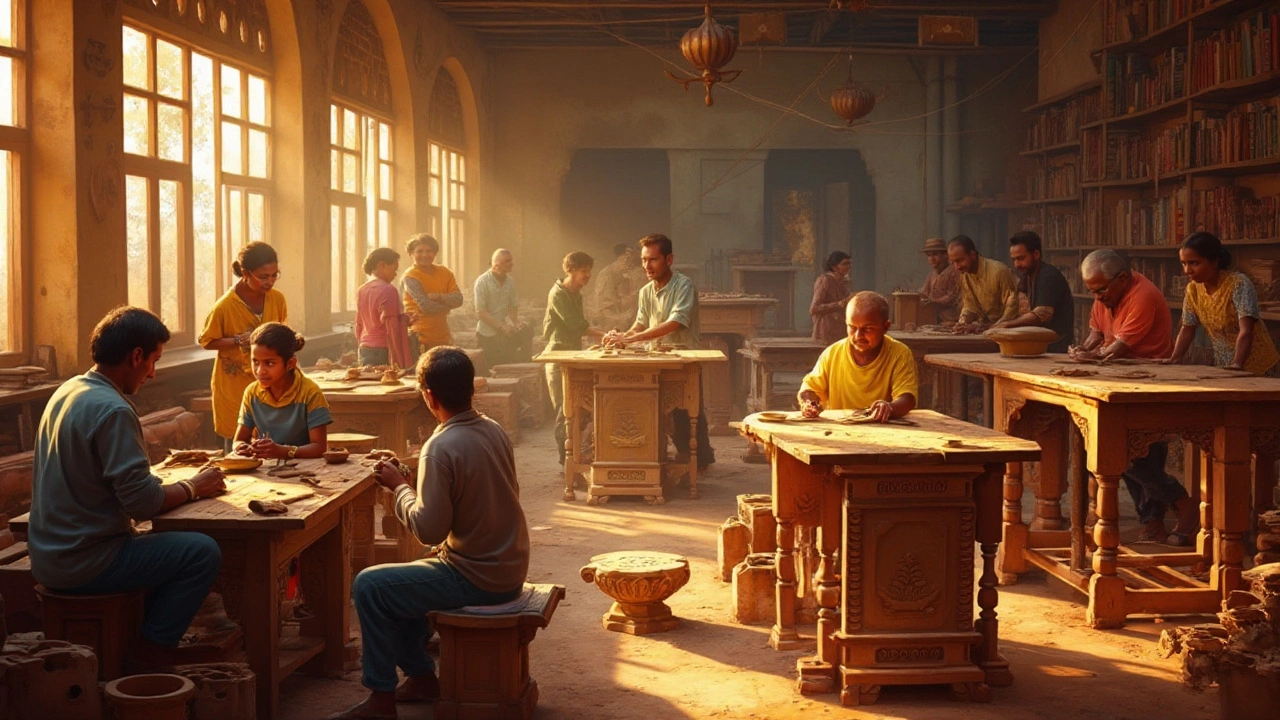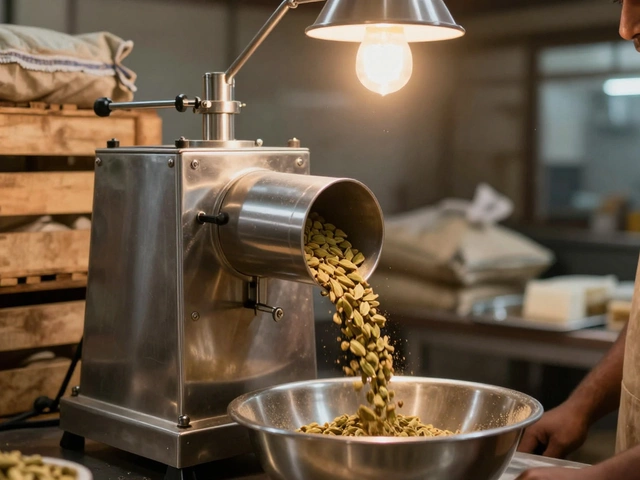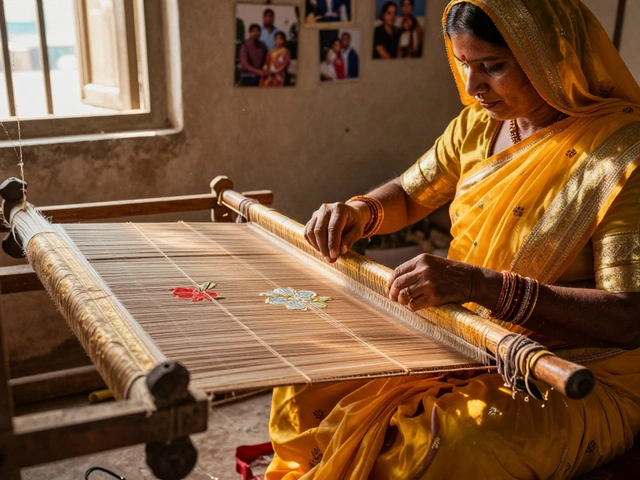The World's Leading Furniture Producer: Spotlight on India

The global furniture industry has witnessed considerable transformation over the years, with countries competing to become the dominant force. As of 2025, India has stepped into the spotlight as the largest producer of furniture in the world. This evolution speaks volumes about the country's resource diversity, skilled artisans, and innovative manufacturing techniques.
What makes India's triumph even more compelling is the blend of its ancient artistry with modern technology. Indian manufacturers have successfully harnessed local materials and the varied expertise of their workforce, creating pieces that are both distinctive and durable. However, the journey wasn't without its challenges. This article aims to delve into how India managed to carve out its place at the top, the obstacles it overcame, and what lies ahead for this booming industry.
- India's Rise in Global Furniture Production
- Key Factors Behind India's Success
- Innovative Strategies in Indian Manufacturing
- Challenges and Future Prospects
India's Rise in Global Furniture Production
India's ascent to becoming the largest producer of furniture in the world is an intriguing tale of innovation, aspiration, and adaptation. Historically, India has been home to intricate and exquisite furniture designs, deeply rooted in its diverse cultural tapestry. This rich legacy of craftsmanship laid the foundation for India's burgeoning furniture manufacturing industry. In recent years, the nation has witnessed a remarkable transformation driven by both internal demand and strategic global positioning. Its position as a leader is not merely a feat of numbers; it is a testament to the country’s ability to blend tradition with modernity.
The nation had to navigate a confluence of factors to achieve such significant status on the global stage. India's vast availability of raw materials like wood, bamboo, and cane has played an instrumental role in boosting its production capabilities. Equally important is the country's talented labor force, which has steadily increased its proficiency in both manual and automated production processes. The government's initiatives to support the furniture manufacturing sector through favorable policies and subsidies have been pivotal. According to a recent report by the Indian Council for Research on International Economic Relations, ‘India’s government has been strategic in creating policies that empower its local industries, thereby adding significant impetus to the nation’s economic growth’.
One cannot overlook the immense potential unleashed by India's investments in technology and infrastructure. The inclusion of modern-day machinery and practices has equipped the industry to cater to sophisticated global demands without compromising traditional artistry. In an interesting development, several prominent global firms have established production facilities in India, capitalizing on its competitive advantages. This move not only provided a boost to local employment but also forged pathways for knowledge transfer in cutting-edge furniture manufacturing techniques.
The successful intertwining of ancient techniques with contemporary designs has allowed Indian furniture producers to cater to diverse international tastes. By understanding and incorporating aspects of sustainability into manufacturing — be it using eco-friendly materials or reducing carbon footprints — India has positioned itself as a responsible leader amid global environmental challenges. The Federation of Indian Chambers of Commerce and Industry provides a compelling statistical insight, highlighting that the Indian furniture sector has grown at a compound annual growth rate of nearly 13% over the last decade, which is a testament to its enduring dynamism and resilience.
As the largest producer, India faces unique challenges such as fluctuating raw material prices and increasing pressure to maintain industry standards while scaling production. Yet, it remains poised to not only navigate these obstacles but to continue growing. The sector is poised for exponential growth, especially as digitization begins to penetrate emerging markets and online retail models offer unprecedented access to consumers worldwide. Such digital growth offers Indian manufacturers a runway to showcase their products to previously untapped demographics across Asia, Europe, and the Americas.
Key Factors Behind India's Success
As we turn our gaze towards the factors propelling India to the forefront of global furniture markets, it's clear that a multitude of elements have converged to craft this success story. The sheer abundance of natural resources plays a pivotal role, offering an extensive variety of raw materials such as timber, bamboo, and cane. These resources are not only plentiful but also diverse, allowing for an array of designs that cater to different aesthetic preferences across the globe. Many manufacturers have tapped into this resource wealth, ensuring that the quality of the materials matches the international standards expected by consumers.
Equally important is the wealth of skilled labor that India possesses. The country has a rich tradition of craftsmanship, with artisans passing down skills through generations. This legacy of craftsmanship is evident in the detail and quality of the furniture produced. The integration of traditional techniques with modern manufacturing methods has resulted in products that honor heritage while meeting contemporary demands. The melding of these two worlds paints a unique narrative that resonates with consumers seeking both authenticity and innovation.
India's strategic approach to the manufacturing process itself has also been revolutionary. Many companies have embraced sustainable practices, recognizing the growing global demand for eco-friendly products. This shift not only aligns with ethical production standards but also positions Indian manufacturers as leaders in sustainable practices. By investing in renewable energy sources and reducing waste, these companies are forging a path that other countries are beginning to follow.
Government initiatives have also contributed significantly to India's rise. Policies aimed at bolstering the local manufacturing industry, coupled with incentives for startups, have created a fertile ground for growth. The 'Make in India' campaign, for instance, has been a catalyst in attracting foreign investment and boosting domestic production. According to industry data, the furniture sector has seen a steady growth trajectory, with exports reaching unprecedented figures year on year.
One cannot overlook the impact of innovation and technology in transforming the furniture industry landscape in India. The adoption of cutting-edge technology—such as computer-aided design (CAD) and automation—has increased efficiency and output quality. This blend of technology with traditional manufacturing processes ensures that Indian furniture is both contemporary and of high quality, appealing to a wide range of markets.
"The future belongs to countries that understand creativity and resourcefulness in manufacturing. India has shown how culture and technology can blend to capture not just market followings, but also admiration," remarked a noted global trade analyst.
In summary, India's ascent as the largest furniture producer is a tapestry woven with rich resources, age-old craftsmanship, strategic governmental support, and an unwavering commitment to sustainability and innovation. Each thread represents a commitment to excellence and vision—a vision that is making waves not just in the domestic market, but is echoing throughout the global furniture industry.

Innovative Strategies in Indian Manufacturing
In the grand tapestry of the global furniture market, India has emerged as a formidable player, thanks to its array of innovative strategies. These strategies have not only propelled India to the forefront but have also redefined how the world perceives its furniture manufacturing capabilities. A pivotal factor is the integration of cutting-edge technology with time-honored traditional craftsmanship. Indian companies recognize the value in blending the old with the new, where artisans complement machinery to create exquisite pieces. This synergy ensures that each item leaving the factory floor resonates with both modern precision and cultural authenticity, setting Indian furniture apart in the global arena.
Another groundbreaking approach has been the emphasis on sustainable and eco-friendly practices. With increasing awareness and concern over the environmental impact of manufacturing, Indian manufacturers are proactively adopting greener methods. From sourcing timber from sustainably managed forests to utilizing non-toxic finishes, these companies are striving to minimize ecological footprints. This commitment not only satisfies a global demand for sustainable products but also positions India as a responsible leader in the industry. A notable example is the increased use of bamboo and rattan, which are rapidly renewable materials, marking a significant shift towards a greener future.
To further advance their global standing, Indian furniture producers have placed strong emphasis on design innovation. By collaborating with international designers, they ensure that their furniture meets diverse tastes while maintaining a distinct Indian flair. This has spurred the development of unique product lines that appeal to different demographics worldwide. Furthermore, the incorporation of digital tools for customizations has empowered customers to have active roles in the creation process, thereby enhancing satisfaction and boosting customer loyalty.
Investment in skill development is another cornerstone of innovativeness in this sector. Programs aimed at training local artisans in modern techniques are widespread, ensuring a versatile and highly proficient workforce. Governments and corporations alike have realized the potential of this vast talent pool and have poured resources into vocational training. This initiative not only elevates the quality of the products but also uplifts communities through better job opportunities, fueling economic growth on a larger scale.
In the words of industry leader Arvind Sharma, "The fusion of technology and tradition is India's unique selling point on the world stage. When you purchase a piece of Indian furniture, you're buying a story—crafted with skill, respect, and imagination."
As India continues to implement these innovative strategies, its influence across the global market is expected to expand exponentially. These practices are not mere transient trends but a testament to India's commitment to evolving with the times while remaining true to its esteemed heritage in furniture manufacturing. By maintaining this delicate balance, the nation stands poised to not only retain its status as the largest producer of furniture but to also lead the industry towards a more inclusive and sustainable future.
Challenges and Future Prospects
The journey to becoming the world's largest furniture producer wasn't paved with gold for India. The nation faced numerous obstacles, each demanding its unique solution. One of the longstanding challenges is the balancing act between tradition and industrialization. India is renowned for its rich heritage of craftsmanship, which often means that artisans use techniques passed down through generations. These methods are treasured for their authenticity but can struggle to keep pace with the mass-production demands of a global market. Industries have had to strategically blend these age-old practices with modern technology, ensuring that products remain competitive without losing their cultural touch.
Another significant hurdle involves resource management. Although India is wealthy in natural resources, which are pivotal in furniture manufacturing, there's an ongoing struggle with maintaining the delicate equilibrium between exploitation and sustainability. Deforestation and resource depletion pose real threats, and the industry is under increasing pressure to adhere to environmentally friendly practices. Innovative solutions, such as using reclaimed wood and eco-friendly materials, are being explored and implemented by many manufacturers to reduce their ecological footprint and cater to an increasingly environmentally-conscious global customer base.
Economic and Political Factors
The economic landscape, too, offers its mix of challenges and opportunities. Fluctuations in raw material prices can drastically affect production costs. The political climate also exerts influence, with policies that can either support industrial growth or add layers of bureaucracy that companies must navigate. Yet, the government has been proactive in setting up Special Economic Zones (SEZs) and offering incentives to bolster the furniture manufacturing sector. Such measures are designed to streamline operations, attract foreign investments, and promote export-oriented growth.
Future Prospects and Innovation
Looking ahead, the future for India's furniture industry appears promising, yet not without its trials. With the rise of digital platforms, there is an undeniable shift towards online retailing. Companies must invest in e-commerce to reach a broader audience, which often means navigating new logistics and distribution strategies. The trend of personalization in furniture is growing, wherein customers seek pieces that reflect their style and preferences. This demands more flexibility and customization options from manufacturers.
"The future of Indian furniture lies in its ability to innovate while staying true to its cultural roots," says Arjun Khanna, CEO of a leading Indian furniture brand.To remain the leader of the global furniture market, companies will need to harness technological advancements without losing the unique touch that sets them apart. Augmented reality and virtual showrooms are emerging as tools that can revolutionize how customers engage with products before purchasing. These innovations can offer a competitive edge in an ever-evolving market.
In conclusion, while India stands as the largest furniture producer globally, its position must be continuously earned and maintained through dedication, innovation, and strategic planning. By effectively tackling the inherent challenges and capitalizing on future opportunities, India can sustain—and even accelerate—its growth in the dynamic global arena.





